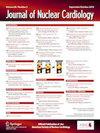正常应激心肌灌注显像患者加性异常应激运动标志物的患病率及其对预后的影响。
IF 2.7
4区 医学
Q2 CARDIAC & CARDIOVASCULAR SYSTEMS
引用次数: 0
摘要
背景:虽然在过去的二十年中,应激心肌灌注成像(MPI)的缺血率有所下降,但许多有症状的患者仍然处于心脏事件的中至高风险。运动负荷、心率反应、心率恢复、血流动力学增益指数和血压对运动的反应已单独确立了预后价值;然而,这些标志物在心肌灌注正常且无缺血性心电图st段抑制(正常应激MPI)患者中的应用尚不清楚。方法:我们对2015-2017年892例应激MPI正常的患者的异常应激运动标志物进行了回顾性、单中心分析。我们测量了与附加异常应激运动标志物相关的死亡或非致死性心肌梗死(NFMI)的患病率和相对风险。结果:患者平均年龄61岁(男性55%)。大多数受试者(82.6%)有可能出现心脏症状。65.1%的患者至少有一种异常标志物,9.6%的患者有三种或三种以上的异常标志物。在对传统危险因素进行调整后,每增加一个标志物,事件的风险逐步增加36%,具有三个或三个以上标志物的患者发生事件的风险最高(HR 2.44 [1.09 - 5.48], p = 0.031)。结论:应激性MPI正常的患者有较高的异常应激运动标志物负担,这导致不良事件的风险逐步增加。这一预后信息强调了运动试验对正常应激性MPI患者风险分层的附加价值,并可能提示无缺血情况下的症状病因。本文章由计算机程序翻译,如有差异,请以英文原文为准。
The prevalence and prognostic impact of additive abnormal stress exercise markers in patients with normal stress myocardial perfusion imaging
Background
While the rate of ischemia on stress myocardial perfusion imaging (MPI) has decreased over the last two decades, many symptomatic patients remain at an intermediate to high risk for cardiac events. Exercise workload, heart rate (HR) response, HR recovery, hemodynamic gain index, and blood pressure response to exercise have established prognostic value in isolation; however, the utility of these markers in patients with normal myocardial perfusion and no ischemic electrocardiogram ST segment depression (normal stress MPI) is unknown.
Methods
We performed a retrospective, single-center analysis of abnormal stress exercise markers in 892 patients who had a normal stress MPI from 2015 to 2017. We measured the prevalence and relative risk for death or non-fatal myocardial infarction associated with additive abnormal stress exercise markers.
Results
The mean age of patients was 61 years (55% male). Most patients (82.6%) had possible cardiac symptoms. At least one abnormal marker was found in 65.1% patients, and 9.6% had three or more markers. After adjustment for traditional risk factors, there was a 36% stepwise increase in the risk for events with each additional marker present, and patients with three or more markers were at the highest risk for events (HR: 2.44 [1.09-5.48], P = .031).
Conclusions
Patients with normal stress MPI have a high burden of abnormal stress exercise markers, which confer a stepwise increase in the risk for adverse events. This prognostic information highlights an added value of exercise testing for risk stratification in patients with normal stress MPI and may suggest symptom etiology in the absence of ischemia.
求助全文
通过发布文献求助,成功后即可免费获取论文全文。
去求助
来源期刊
CiteScore
5.30
自引率
20.80%
发文量
249
审稿时长
4-8 weeks
期刊介绍:
Journal of Nuclear Cardiology is the only journal in the world devoted to this dynamic and growing subspecialty. Physicians and technologists value the Journal not only for its peer-reviewed articles, but also for its timely discussions about the current and future role of nuclear cardiology. Original articles address all aspects of nuclear cardiology, including interpretation, diagnosis, imaging equipment, and use of radiopharmaceuticals. As the official publication of the American Society of Nuclear Cardiology, the Journal also brings readers the latest information emerging from the Society''s task forces and publishes guidelines and position papers as they are adopted.

 求助内容:
求助内容: 应助结果提醒方式:
应助结果提醒方式:


